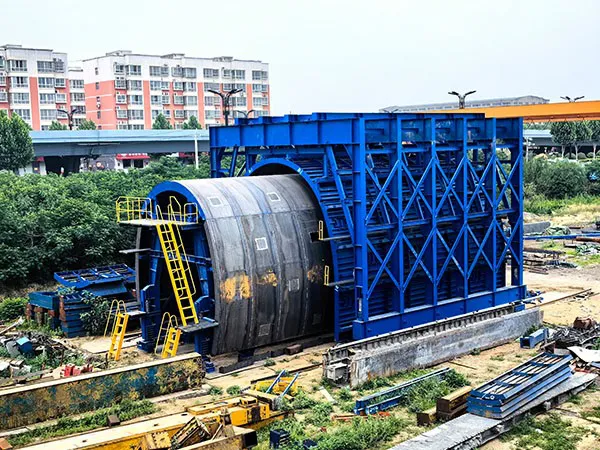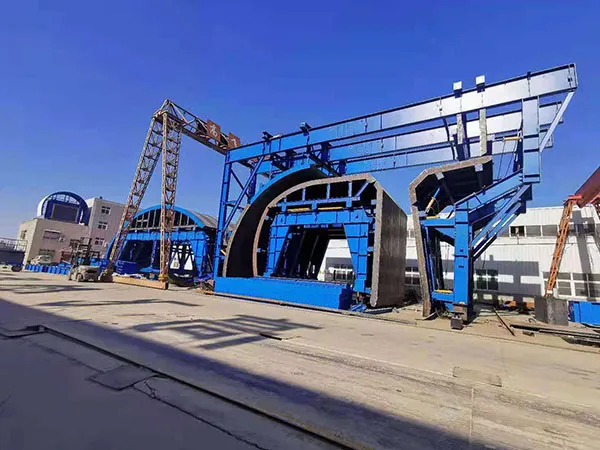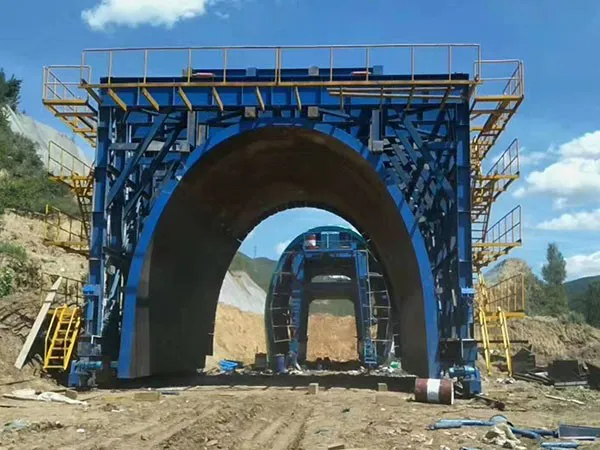Troubleshooting the hydraulic system of a tunnel lining trolley involves a systematic approach, starting with basic checks and progressing to more complex diagnostics. The most common issues relate to pressure, temperature, and contamination.

To troubleshoot, you need to know what you're looking at. A typical tunnel lining trolley hydraulic system includes:
Hydraulic Power Unit (HPU):
Reservoir (Tank): Holds the hydraulic fluid.
Electric Motor or Diesel Engine: Drives the pump.
Hydraulic Pump: Creates the flow of fluid.
Filters: Clean the fluid (suction, pressure, and return lines).
Heat Exchanger (Cooler): Prevents the fluid from overheating.
Control Valves:
Directional Control Valves: Direct the fluid to the correct actuator (often solenoid-operated).
Pressure Relief Valve: The system's primary safety valve, it opens to send fluid back to the tank if pressure gets too high.
Flow Control Valves: Regulate the speed of actuators.
Check Valves & Pilot-Operated Check Valves: Allow flow in one direction and are used to lock cylinders in place.
Actuators:
Hydraulic Cylinders: Perform the work (lifting/lowering the gantry, expanding/retracting the formwork, propulsion, steering).
Conductors:
Hoses and Pipes: Transport the fluid.
Don't just start replacing parts. Follow a logical process.
Step 1: Gather Information & Observe
What is the exact problem? (e.g., "The main lift cylinders won't extend," "The whole system is slow," "The pump is making a loud screaming noise.")
When did it start? Was it a sudden failure or a gradual decline in performance?
Were there any recent repairs or changes?
Observe the machine in operation (if safe to do so).
Listen: Are there new or unusual noises (whining, grinding, banging)?
Look: Are there any visible leaks? Is any hose vibrating excessively or jumping?
Smell: Do you smell burning oil?
Feel: Check for excessive heat at components (use an infrared thermometer, not your hand).
Step 2: Start with the Easiest Checks First
Before you get out the big wrenches, check the fundamentals. Over 50% of hydraulic problems are caused by simple issues.
Check the Hydraulic Fluid Level: Is it low? A low level can cause the pump to cavitate (suck air), leading to noise, heat, and damage.
Check the Hydraulic Fluid Condition:
Milky/Cloudy: Water contamination.
Dark/Burnt Smell: Oil is overheated and oxidized.
Foamy: Air is getting into the system (aeration).
Check Filter Indicators: Most filters have a visual or electrical indicator that shows when they are clogged. A clogged filter can starve the pump or restrict flow.
Check for Obvious Leaks: Inspect all hoses, fittings, and cylinder seals.
Check Power Supply: Is the electric motor or diesel engine running correctly? For electric motors, check that all three phases have power.

Here is a breakdown of common symptoms, their likely causes, and how to diagnose them.
Problem 1: System Has No Power / No Functions Work
|
Possible Cause |
Troubleshooting Steps |
|
No power to the pump |
1. (Electric): Check main breaker, fuses, and motor contactor. Is the motor running? 2. (Diesel): Is the engine running? Is the pump engaged? |
|
Low hydraulic fluid level |
Check the sight glass on the reservoir. Top up with the correct, clean fluid if low. |
|
Main pressure relief valve stuck open |
The pump is running, but all fluid is dumping directly back to the tank. Listen near the valve; you may hear it bypassing. Check the pressure gauge—it will read very low or zero. |
|
Pump failure (catastrophic) |
The motor may trip the breaker, or you may hear a loud grinding/banging followed by silence. This is a major failure. |
|
Broken pump shaft or coupling |
The motor runs, but the pump shaft isn't turning. Perform LOTO and visually inspect the coupling between the motor and pump. |
Problem 2: System is Slow or Sluggish
|
Possible Cause |
Troubleshooting Steps |
|
Clogged suction strainer or return filter |
The pump is starved for oil. Check filter indicators. Replace filters. |
|
Worn pump |
The pump is no longer efficient. This is usually a gradual failure. Check system pressure while operating a function against a load. If it can't reach the pressure set on the relief valve, the pump may be worn. |
|
Internal leak |
A major internal leak (e.g., at a relief valve, a cylinder's piston seal, or a control valve) is bleeding off flow. Use an infrared thermometer to find hot spots, as the point of a high-pressure leak generates significant heat. |
|
Fluid is too thick (wrong viscosity) |
Is the ambient temperature very cold? Has the wrong fluid been added? |
|
Pressure relief valve set too low |
Check the system pressure gauge. If pressure is low, the relief valve may be set incorrectly or failing. |
Problem 3: A Single Function is Not Working or is Erratic
Example: The formwork won't expand, but all other functions work.
|
Possible Cause |
Troubleshooting Steps |
|
Solenoid on the directional valve has failed |
1. Listen for the "click" when the control is activated. 2. Use a multimeter to check for voltage at the solenoid's electrical connector. 3. Many valves have a manual override pin—use a small tool to press it and see if the valve shifts. |
|
Directional valve is stuck |
Contamination can cause the spool inside the valve to stick. The solenoid may click, but nothing happens. May require removing and cleaning or replacing the valve. |
|
Pilot-operated check valve or counterbalance valve is stuck |
These valves are designed to lock cylinders in place. If they fail to open, fluid can't get to or from the cylinder. |
|
Hose or pipe is blocked or damaged |
Visually inspect the hoses leading to that specific cylinder. |
Problem 4: System is Overheating
|
Possible Cause |
Troubleshooting Steps |
|
Low hydraulic fluid level |
The smaller volume of fluid cycles more often and can't dissipate heat. Top up. |
|
Dirty heat exchanger (cooler) |
The cooler fins are clogged with concrete dust and dirt. Clean thoroughly with compressed air or a pressure washer (be careful not to damage the fins). |
|
Cooler fan is not working |
Check the fan motor, belts, or hydraulic motor that drives the fan. |
|
System is working continuously over the relief valve |
This is a major source of heat. The system pressure is constantly at max, and the relief valve is dumping hot oil back to the tank. This could be due to an operator holding a control after a cylinder has fully extended/retracted, or a faulty pressure switch. |
|
Significant internal leak |
As mentioned before, a large internal leak generates a lot of heat. |
Problem 5: Pump is Excessively Noisy
A high-pitched whining sound is often Cavitation. The pump is struggling to pull in fluid.
Causes: Low fluid level, clogged suction strainer, air leak on the suction side of the pump (e.g., a loose fitting), fluid is too thick.
A "marbles" or grinding sound is often Aeration. Air is entering the system and being compressed.
Causes: Air leak in the suction line, leaking pump shaft seal, fluid returning to the tank above the fluid level and splashing.
Problem 6: Cylinder "Drifts" or Won't Hold Position
|
Possible Cause |
Troubleshooting Steps |
|
Leaking piston seals inside the cylinder |
This is a very common cause. To test: Extend the cylinder under load, shut down the system, and disconnect the hydraulic line from the retract port. If oil leaks out of that port, the piston seals are bad. |
|
Leaking holding valve |
The pilot-operated check valve or counterbalance valve associated with that cylinder is leaking internally. If the cylinder test above shows no leak, the valve is the likely culprit. |

Basic Hand Tools: Wrench and socket set, screwdrivers, etc.
Hydraulic Pressure Gauge Kit: This is the most important tool. You cannot diagnose pressure issues without it. Get a kit with various fittings.
Infrared (IR) Thermometer: Excellent for safely finding hot spots that indicate internal leaks or flow restrictions.
Multimeter: For checking voltage at solenoids and other electrical components.
Clean Rags and Containers: Keeping contaminants out is critical during any repair.
Hydraulic Schematic: Your roadmap to the system. Keep it handy.
In summary, this is a comprehensive guide to troubleshooting the hydraulic system of tunnel lining trolleys (also known as formwork gantry or formwork transporter). We use a systematic approach, starting with safety considerations and progressing from simple inspections to more complex diagnostics. Feel free to contact us if you have any questions.
Gaofei
Address: 200m east of tulip garden, group 12 of zhangling community, hongshan street office, hongshan town, xigong district, Luoyang
Tel: +8616638856888
Contact: Gaofei Huang
Mobile: +86-18637923976
Phone: 0379-80881719/ 0379-60162687
QQ: 286827457
E-mail: gaofei@gf-bridge-tunnel.com